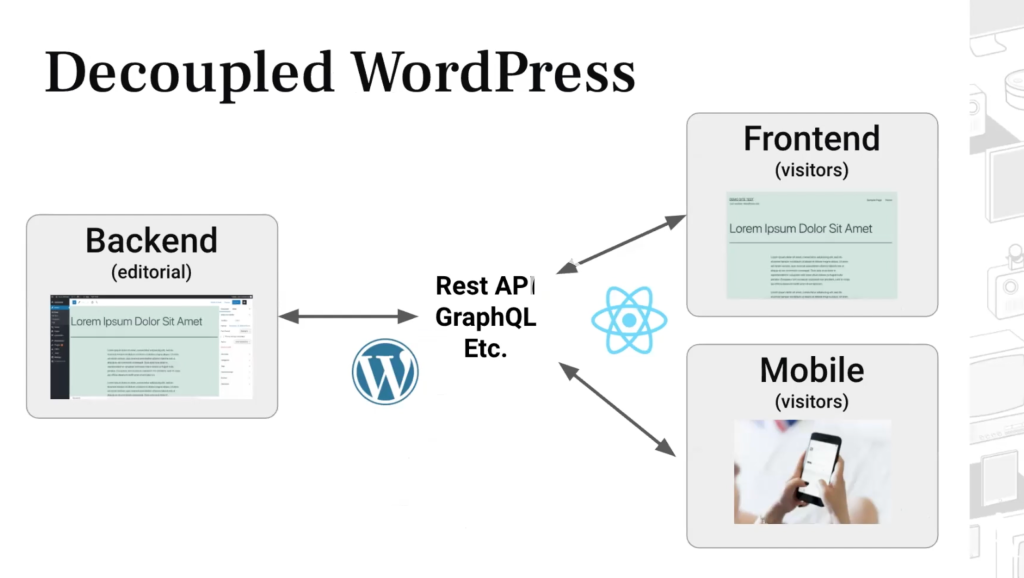In the world of content management systems, there are many approaches you could consider when building your website. Today we’ll look at three popular options: traditional WordPress, JAMstack, and decoupled WordPress.
Which one is the right fit for your organization and its needs?
Let’s explore three different approaches to building your website, along with the advantages and disadvantages of each in such areas as security, costs, and accessibility.
Traditional WordPress: Intuitive but More Limited
On one end of the spectrum is the original WordPress, renowned for being easy to install, user-friendly, and continuously improved with the help of more than 50,000 plugins and counting. WordPress has evolved even further in recent years with the addition of REST API and Gutenberg.
The REST API allows WordPress to communicate and exchange data with other sites or apps. It is what makes headless WordPress possible.
Headless WordPress, or decoupled WordPress, is any site that uses WordPress as its backend content management system while using separate software to display information on the front end.
The API is at the heart of the Javascript-based block editor Gutenberg. Through this innovative block editor, social embeds, videos, — and more — can be inserted, rearranged, and styled on the fly with very little technical knowledge
These two features aren’t just nice to have; they’re essential to the continued evolution of WordPress.
Compared to traditional WordPress, headless technology offers heightened security by hiding the back end from the public. Also, being less reliant on plugins allows more speed.
JAMstack: Quick and Versatile but Enigmatic
On the opposite end is JAMstack, which is a relatively new approach to websites that stands for Javascript, APIs, and Markup.
These websites are super fast and fun to build, enabling you to piece together a patchwork of services to create a custom stack.
This means, however, that JAMStack assumes a certain level of programming expertise, even on the editorial side. Thus, while JAMstack sites are fun to build, they might be too technical and brittle for most users.
Decoupled WordPress: The Best of Both Worlds?

If traditional WordPress and JAMStack are at opposite ends, then decoupled WordPress (also known as headless WordPress) is somewhere in the middle.
Traditionally, backends and frontends have been powered and driven by the same thing.
But does that really make sense given the different wants and needs of back-end versus front-end users? While editors might want powerful tools to be successful, front-end users care more about their experience being quick and nimble.
With decoupled (or headless) sites, you can meet the needs and desires of each group of users without sacrificing what’s best for the other group.
Backends and frontends are isolated from each other, meaning that you can use the right technology stack for reach.
How Do the Three Compare In Key Areas?
Let’s take a look at how traditional WordPress, JAMStack sites, and decoupled WordPress compare in different areas:
Performance: Users have incredibly high expectations for speed on the web. Page load time can affect everything from conversions, to time on site, to sign-ups. JAMstack and Headless WordPress are inherently super fast and, thus, at an advantage. To compensate, if you’re using traditional WordPress, you should follow best practices like using compressed images and caching static content in order to improve speed. While it might not give you transformative speed increases, every little bit matters.
Accessibility: Traditional WordPress includes many accessibility features out of the box, as this is an important value in the WordPress community. The JavaScript libraries powering JAMstack and Headless WordPress can be perfectly accessible, but you may find you need to be more intentional in these environments with planning and implementing accessibility in a systematic way.
SEO: Decoupled or not, the strategy in general for SEO will be the same: Optimize load times and generate good content. One of the significant advantages of traditional WordPress is that you have a vast library of plugins to assist you with SEO, including Yoast and AMP. With JAMstack and headless WordPress, you’ll need to rely less on WordPress and plugins and more on developers to meet SEO goals. This is changing as plugins like Yoast adapt to headless WordPress.

Security: As mentioned before, traditional WordPress may be more susceptible to security threats because of its open-source nature and popularity. Still, WordPress does implement measures to improve this, including network security like firewalls and DDoS protection, data security that protects your site’s data and files from access and vulnerability management which ensures that your code is secure. And while JAMstack’s flat files limit opportunities for attack, no single approach eliminates the need for diligence against security threats. While headless offers heightened security, strategies largely depend on specific tooling and services. In the end, it’s your responsibility to manage good security hygiene, regardless of how your site was built. Some measures that minimize security risks include selecting a reputable host, fully vetting any software libraries you use, ensuring you have a strategy for keeping code updated, and training your staff to use tools like two-factor authentication.
Developer Experience: Modern JavaScript frameworks can make building and maintaining Headless WP and JAMstack sites enjoyable. Developer experience has never been the focus of traditional WordPress, but the community is awesome.
Content Creators & Publishers: The editorial experience with JAMstack is still sub-par, but improving. Publishers and content creators love the sophistication of WordPress (headless or traditional).
Costs: No single approach is inherently cheaper. A lot depends on a site’s usage and needs.
Traction & Growth: JAMstack and Headless WordPress are not fads. Headless WordPress is transitioning from one-off solutions to mature frameworks, including Irving and Frontity. There is also better support from WordPress Core and the plugin community,
Still Undecided On Which CMS Type Is Best for You? We Can Help!
At Alley, we can help you evaluate your current organization’s needs and which CMS type fits best. Contact us to learn more!
